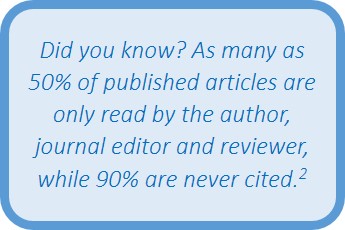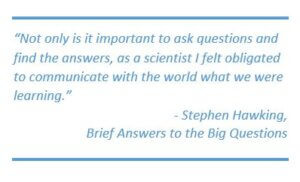
Are article summaries a solution to the problem ‘how to increase your citations?’ How do you measure your contribution in your field and as a researcher? In a world of science and research balanced on impact, where do you stand? Earlier, the measure of a researcher’s success was getting their work published, but things have changed. Apart from the number of scholarly articles under your belt, it is also important to consider where your research is being published and how much of an impact it has had, which raises the question – how to increase your citations. This trend is also backed by an interesting study that uses data from Thomson Reuters Web of Science to claim that a scientist’s reputation and standing within the academic community is now linked to both the quantity and quality of his or her published work.1 While a boon for the world, this puts the onus on researchers to ensure they communicate their research effectively.

A researcher’s responsibility does not stop after publication; evidence indicates that author reputation can account for a significant increase in citations of a research paper.1 But how can researchers establish their reputation and be recognized for their work globally? Millions of scholarly articles are being published every year, but how do you increase journal citations by ensuring that your research gets the visibility and engagement it deserves? One daunting study on readership and research paper citations in academia shows that as many as 50% of published articles are only read by three people (the author, journal editor, and reviewer), while 90% are never cited.2 Regardless of its importance, published articles can fall through the cracks unless it is made more palatable for those in the scientific community and beyond. This is where educative, interesting, and simple summaries of scientific papers can help you reach and engage with a wider audience, giving you the chance to increase citations.
How to increase your citations and expand your reach with article summaries
The world of research is opening up. With the popularity of open-access platforms, research findings have become more accessible than ever. And this is not restricted to those within academia; there is a growing interest in new research developments and its potential impact on the larger world. The best example in recent times has been the keen interest on research related to the COVID-19 pandemic or climate change. This is where a well-written article summary can help you highlight the potential of your study, showcase your research findings effectively to increase citations, and drive real-world impact.

Research is only useful if it can be used to support and build new discoveries. However, while looking for relevant scholarly articles for their research, academics usually only have time to skim the abstract to determine a paper’s usefulness. However, abstracts can sometimes be too technical or complex to understand, making it likely that your paper will be ignored. So then, how to increase your citations in a research paper? Here, including well-written article summaries give you an advantage by making your paper more discoverable and easy to understand, which will increase citations for your paper as more researchers choose to use it as the foundation for new discoveries. Researchers can also share these article summaries with policymakers to generate interest and influence policy changes within the larger community.
While article summaries are a great way to increase citations and engage your audience post-publication, they are also a value add for researchers conducting their research or preparing their manuscript. Article summaries are common when applying for grants, allowing decision makers to better understand the importance and relevance of the proposed research project. Since most of the R&D funds come from taxpayer money, this also allows stakeholders to justify fund allocation.3 Similarly, including summaries of articles as part of your submission package helps journal editors quickly evaluate and understand how it fits with the journals scope. Another study, published in the journal eLife, indicates a growing number of journals and scientific organizations are requesting or creating article summaries to make the research more appealing for a wider audience, increasing citations, boosting visibility and driving impact.4
Despite being a great tool for effective research communication, writing article summaries is not an easy task for authors who are already stretched for time as they work to polish their manuscript and deliver a winning submission package. For most, the challenge is being able to explain your work in simple terms, while using the right language and content to make it informative and appealing to a broad set of people with different levels of scientific education. Creating article summaries can take too much time and effort, even if it can help increase citations; it may seem hard to justify for researchers already stretched for time as they work to deliver a publication-ready manuscript. This is where Researcher.Life comes in with to help stressed authors win on both counts.
How can Researcher.Life work for you
Based on intelligence gained from interactions with over a million researchers over the past 20+ years, Researcher.Life is an ecosystem of smart tools and services designed to support researchers. It offers researchers the chance to sign up for free and access 10+ benefits, including Research Projects, which comes with a powerful AI manuscript optimization tool and bespoke article summaries to help you solve the problem of how to increase your citations.
My Research Projects’ advanced AI platform assesses research manuscripts across the key factors most journal editors check for. Secure, detailed, instant and free, its comprehensive manuscript submission readiness check puts your paper through an in-depth evaluation, suggests ways to refine your work by highlighting problem areas in a detailed report and helps you find and fix problem areas that could lead to desk rejection.
My Research Projects also offers bespoke AI-powered article summaries to help researchers simplify and streamline their submission process. Powered by Scholarcy’s AI algorithm, it summarizes your manuscript in minutes. It uses the most important phrases and findings in your study to accurately explain your research in bite-sized sections. What’s more, these summaries of your academic papers also identify the top keywords for your research, ensuring your paper will be more discoverable post-publication, which can help you boost citations for your research paper.
To conclude, creating compelling research manuscripts and robust article summaries are a great way for authors to get their work seen and drive impact with increased citations. In addition to communicating your research and accomplishments to a global audience, it also strengthens your reputation as a top researcher in your field. This, in turn, can help you boost citations for your research paper, forge collaborations with other scientists for high-impact research, secure the funding you need, and advance your career. Ready for greatness? Take the first step with Researcher.Life! Register for free today to check your manuscript’s submission readiness and get the first research paper summary free!
References:
- Petersen, A.M. et al. Reputation and impact in academic careers. Proceedings of the National Academy of Sciences, 2014. Retrieved from https://www.pnas.org/content/early/2014/10/03/1323111111.abstract?sid=cfe6f1f4-f2e7-43e0-b54b-c3aa1a64c810
- Eveleth, R. Academics Write Papers Arguing Over How Many People Read (And Cite) Their Papers. Smithsonian Magazine, 2014. Retrieved from https://www.smithsonianmag.com/smart-news/half-academic-studies-are-never-read-more-three-people-180950222/#O5q1GSA4FStDC9HX.99
- Rajagopalan, J. Lay summaries are not just for researchers, they are for funders, too. Editage Insights, 2017. Retrieved from https://www.editage.com/insights/lay-summaries-are-not-just-for-researchers-they-are-for-funders-too?loginform=loggedin-normal
- Shailes, S. Plain-language Summaries of Research: Something for everyone. eLife, 2017. Retrieved from https://elifesciences.org/articles/25411


